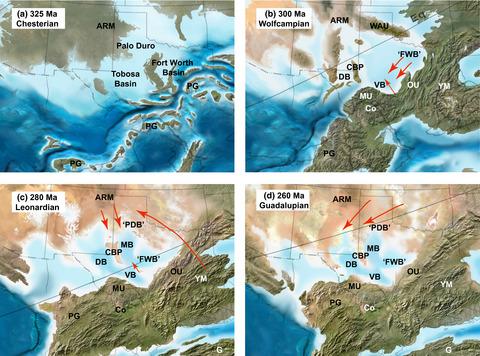当前位置:
X-MOL 学术
›
Basin Res.
›
论文详情
Our official English website, www.x-mol.net, welcomes your
feedback! (Note: you will need to create a separate account there.)
Tectonic controls on the evolution of mixed carbonate-siliciclastic systems: Insights from the late Palaeozoic Ouachita-Marathon Foreland, United States
Basin Research ( IF 2.8 ) Pub Date : 2021-02-15 , DOI: 10.1111/bre.12557 Li Liu 1, 2, 3 , William A. Ambrose 2 , Timothy F. Lawton 2 , Daniel F. Stockli 3
Basin Research ( IF 2.8 ) Pub Date : 2021-02-15 , DOI: 10.1111/bre.12557 Li Liu 1, 2, 3 , William A. Ambrose 2 , Timothy F. Lawton 2 , Daniel F. Stockli 3
Affiliation

|
Sea level is thought to be the primary driver of alternating deposition of carbonate and siliciclastic sediment in shelf settings, with carbonates dominating during transgressive/highstands and siliciclastics during lowstands. Although sediment supply is critically important for shelf-margin growth in siliciclastic systems, few studies demonstrate its impact on mixed carbonate-siliciclastic systems. The Permian Basin in Texas, United States, provides an opportunity to investigate the basin evolution regarding the source, sediment routing and particularly shelf/slope growth from syn- to postorogenic phases during alternating carbonate and siliciclastic sedimentation. Published detrital zircon data show that the proportion of orogen-related sources decreased significantly from an earliest Permian synorogenic phase (ca. 298 Ma) to a Leonardian (ca. 280–271 Ma) postorogenic phase, in concert with a grain-size change from fine- to medium-grained sand to silt. Although along-strike lateral variabilities exist on the shelf margin, the shelf-margin evolution characteristics show a significant difference among the Northern Shelf, Eastern Shelf and Central Basin Platform. The synorogenic Eastern Shelf exhibits a significant higher progradation rate than does the postorogenic Northern Shelf. The progradation and aggradation ratio of siliciclastic-rich intervals in the Eastern Shelf is significantly higher than those of carbonate-rich intervals in the Eastern Shelf and carbonate- or siliciclastic-rich intervals in the Northern Shelf. In contrast, the Central Basin Platform, with no siliciclastic sediment supply, records almost no progradation regardless of orogenic phases. There is an increase in slope gradient with decreasing sediment supply during this second-order sequence from the Permian Cisuralian Series to the end of the Guadalupian Series. This study demonstrates that tectonically driven siliciclastic sediment supply was the main mechanism controlling the shelf and slope evolution in alternating siliciclastic and carbonate deposition.
中文翻译:

对混合碳酸盐-硅质碎屑系统演化的构造控制:来自美国晚古生代 Ouachita-Marathon Foreland 的见解
海平面被认为是陆架环境中碳酸盐和硅质碎屑沉积物交替沉积的主要驱动因素,碳酸盐在海进/高位期间占主导地位,而在低位期间以硅质碎屑为主。尽管沉积物供应对于硅质碎屑系统中陆架边缘的生长至关重要,但很少有研究证明其对碳酸盐-硅质碎屑混合系统的影响。美国得克萨斯州的二叠纪盆地提供了一个机会,可以研究在碳酸盐岩和硅质碎屑交替沉积过程中盆地演化的来源、沉积物路径,特别是从同生相到造山后相的陆架/斜坡生长。已发表的碎屑锆石数据表明,从最早的二叠纪共生期(约 298 Ma)到莱昂纳期(约 298 年),造山带相关来源的比例显着下降。280-271 Ma) 后生阶段,伴随着从细粒到中粒砂到粉砂的粒度变化。尽管陆架边缘存在沿走向的横向变异,但北陆架、东陆架和中央盆地台地陆架边缘演化特征存在显着差异。同造东陆架比造山后北陆架表现出明显更高的进积速率。东部陆架富硅质碎屑层段的进积和加积比明显高于东部陆架富碳酸盐层段和北部陆架富碳酸盐或硅质碎屑层段。相比之下,中央盆地台地没有硅质碎屑沉积物供应,无论造山期如何,几乎没有任何进积记录。在从二叠纪 Cisuralian 系列到瓜达卢普阶结束的这个二级层序期间,随着沉积物供应的减少,坡度梯度增加。这项研究表明,构造驱动的硅质碎屑沉积物供应是控制硅质碎屑和碳酸盐交替沉积中陆架和斜坡演化的主要机制。
更新日期:2021-02-15
中文翻译:

对混合碳酸盐-硅质碎屑系统演化的构造控制:来自美国晚古生代 Ouachita-Marathon Foreland 的见解
海平面被认为是陆架环境中碳酸盐和硅质碎屑沉积物交替沉积的主要驱动因素,碳酸盐在海进/高位期间占主导地位,而在低位期间以硅质碎屑为主。尽管沉积物供应对于硅质碎屑系统中陆架边缘的生长至关重要,但很少有研究证明其对碳酸盐-硅质碎屑混合系统的影响。美国得克萨斯州的二叠纪盆地提供了一个机会,可以研究在碳酸盐岩和硅质碎屑交替沉积过程中盆地演化的来源、沉积物路径,特别是从同生相到造山后相的陆架/斜坡生长。已发表的碎屑锆石数据表明,从最早的二叠纪共生期(约 298 Ma)到莱昂纳期(约 298 年),造山带相关来源的比例显着下降。280-271 Ma) 后生阶段,伴随着从细粒到中粒砂到粉砂的粒度变化。尽管陆架边缘存在沿走向的横向变异,但北陆架、东陆架和中央盆地台地陆架边缘演化特征存在显着差异。同造东陆架比造山后北陆架表现出明显更高的进积速率。东部陆架富硅质碎屑层段的进积和加积比明显高于东部陆架富碳酸盐层段和北部陆架富碳酸盐或硅质碎屑层段。相比之下,中央盆地台地没有硅质碎屑沉积物供应,无论造山期如何,几乎没有任何进积记录。在从二叠纪 Cisuralian 系列到瓜达卢普阶结束的这个二级层序期间,随着沉积物供应的减少,坡度梯度增加。这项研究表明,构造驱动的硅质碎屑沉积物供应是控制硅质碎屑和碳酸盐交替沉积中陆架和斜坡演化的主要机制。











































 京公网安备 11010802027423号
京公网安备 11010802027423号